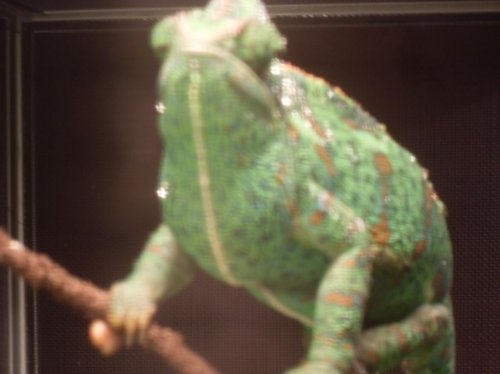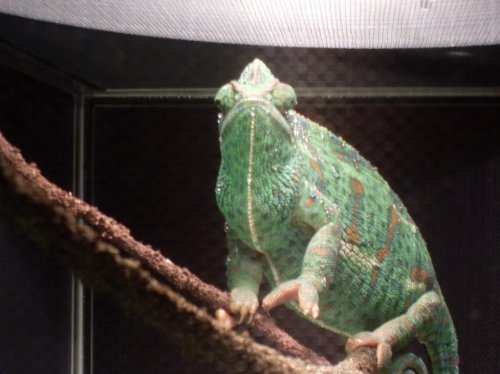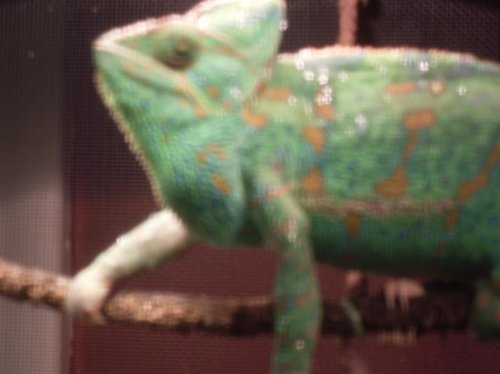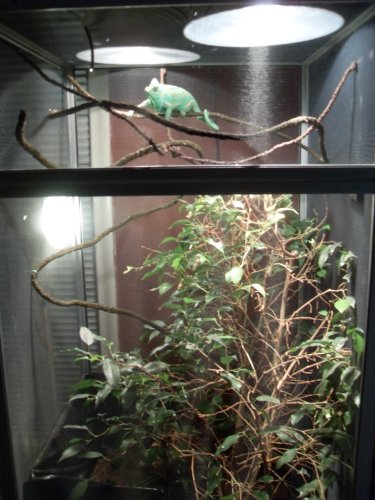If anyone could give me any advise I would be very grateful, I hate for this to be my first post but this just barely came about and the first time I have seen my female cham like this. She has gotten all puffy in the neck region and im not sure what it is or what to do. The daily routine seems to have been working for over a year and a half so im not sure if its just a freak thing or what. I feed her approx. 15-20 crickets every other day, dusting with a calcium sup. also water atleast 2 times a day for about 3-5 mins at a time as well as I have a drip system in place for in between times. I do have some pictures I will post along with this and hopefully someone will be able to see and help.
Navigation
Install the app
How to install the app on iOS
Follow along with the video below to see how to install our site as a web app on your home screen.
Note: This feature may not be available in some browsers.
More options
You are using an out of date browser. It may not display this or other websites correctly.
You should upgrade or use an alternative browser.
You should upgrade or use an alternative browser.
Edema?
- Thread starter STEB4311
- Start date
OldSkoolxReasons
New Member
You need to use plain calcum at almost ever feeding. She is getting wayyy to much D# when dusting with that so often. Most people use rep cal with D3 once every 2 weeks, or even less if the chams are outdoors. The plain calcium is hard to find at petstores for me so I ordered it at LLLreptile. It has a green label, but there are plenty of other plain calciums you can use. Just stop using the one with D3 so much.
Justin
Justin
Welcome to the forum!
IMHO...there is no need to stop using phos.-free calcium to get rid of edema IMHO. I would worry about the D3 and prEformed vitamin A. Chameleons can also develop edema when gravid that will usually go away after they lay the eggs/give birth.
Here are some sites that might help...
http://web.archive.org/web/20060502074341/www.chameleonjournals.com/vet/index.php?show=7.Edema.html
http://chamworld.blogspot.com/2008/01/health-section-f-gout_28.html
http://www.seavs.com/case_studies/lizards/chameleons.asp
Does your female have a place to lay eggs? From the amount you are feeding her and the temperature in the basking area its quite likely she will produce eggs (if she's not already producing them). Veileds don't need to mate to produce eggs. If you don't provide a proper site for her to dig to show you that she is ready to lay eggs, she could become eggbound and die. I hope she isn't past the point of laying already. Does she sit high in the cage? Has she been roaming the cage? Keeping her eyes open during the day? Drinking more than usual?
Also, do you have a UVB light on the cage?
Regarding supplements...
I dust the insects before giving them to the chameleon at most feedings with a phos.-free calcium powder to help make up for the often poor ratio of calcium to phos. found in many of the feeder insects.
I dust twice a month lightly with a phos.-free calcium/D3 powder to ensure that the chameleon gets some D3 without overdoing it and leaving it to get the rest from the UVB light.
I dust twice a month with a vitamin powder that has a beta carotene source of vitamin A. Beta carotene (prOformed vitamin A) will not build up in the system...however, there is controversy as to whether all/any chameleons can convert it....so some people give a little prEformed once in a while. Excess prEformed vitamin A may interfere with the D3 and push the chameleon towards MBD...so be very careful with it.
Calcium, phos., D3 and vitamin A are all important components in bone health and need to be in balance. You need to look at the supplements, what you feed to the chameleon and what you feed to the insects when trying to balance them.
IMHO...there is no need to stop using phos.-free calcium to get rid of edema IMHO. I would worry about the D3 and prEformed vitamin A. Chameleons can also develop edema when gravid that will usually go away after they lay the eggs/give birth.
Here are some sites that might help...
http://web.archive.org/web/20060502074341/www.chameleonjournals.com/vet/index.php?show=7.Edema.html
http://chamworld.blogspot.com/2008/01/health-section-f-gout_28.html
http://www.seavs.com/case_studies/lizards/chameleons.asp
Does your female have a place to lay eggs? From the amount you are feeding her and the temperature in the basking area its quite likely she will produce eggs (if she's not already producing them). Veileds don't need to mate to produce eggs. If you don't provide a proper site for her to dig to show you that she is ready to lay eggs, she could become eggbound and die. I hope she isn't past the point of laying already. Does she sit high in the cage? Has she been roaming the cage? Keeping her eyes open during the day? Drinking more than usual?
Also, do you have a UVB light on the cage?
Regarding supplements...
I dust the insects before giving them to the chameleon at most feedings with a phos.-free calcium powder to help make up for the often poor ratio of calcium to phos. found in many of the feeder insects.
I dust twice a month lightly with a phos.-free calcium/D3 powder to ensure that the chameleon gets some D3 without overdoing it and leaving it to get the rest from the UVB light.
I dust twice a month with a vitamin powder that has a beta carotene source of vitamin A. Beta carotene (prOformed vitamin A) will not build up in the system...however, there is controversy as to whether all/any chameleons can convert it....so some people give a little prEformed once in a while. Excess prEformed vitamin A may interfere with the D3 and push the chameleon towards MBD...so be very careful with it.
Calcium, phos., D3 and vitamin A are all important components in bone health and need to be in balance. You need to look at the supplements, what you feed to the chameleon and what you feed to the insects when trying to balance them.
She does have a space to lay her eggs, on the bottom of the cage there is a large box filled with a soil/sand mixture that i have had for her to use in the past, she is gravid right now and she is about to lay her eggs or soon to be. She has been roaming in and out of the box so she seems to be aware that it is in the cage again.
She does roam around the cage all day, only to sit every so often. i do have uvb lights on the side of the cage. She does keep her eyes open and is "scanning with eyes" constantly. It doesnt seem like she drinking any more than usual..
Thanks Kinyonga.
She does roam around the cage all day, only to sit every so often. i do have uvb lights on the side of the cage. She does keep her eyes open and is "scanning with eyes" constantly. It doesnt seem like she drinking any more than usual..
Thanks Kinyonga.
Last edited:
pssh
Avid Member
Do you mean that the UVB is not on top of the cage? Or on top but to one side? If it is actually on the side of the cage, move it to the top. Gravid females sometimes develop edema, but I think it's a combination of your calcium with d3 and her being gravid.
After she has layed her eggs this time if you follow the directions in this website, you can stop her from laying eggs so you can prolong her life.
http://raisingkittytheveiledchameleon.blogspot.com
After she has layed her eggs this time if you follow the directions in this website, you can stop her from laying eggs so you can prolong her life.
http://raisingkittytheveiledchameleon.blogspot.com
I would have to double check but i think they all stated that they were either uva or uvb i know the one on the side is for sure a uvb but if its better suited on the top i will deffinately move it up there. i have built a stand (2x2) piece of wood that is raised so that its towards the top and a vine runs along side of it and she is Always sitting on that vine directly in front of it for some reason or the other. Not sure if that is good enough but i was also thinking after hearing everyone talk about the tube light, i planned on purchasing one of those and putting it in between the other lights on the top.
Thanks pssh.
Thanks pssh.
Brad Ramsey
Retired Moderator
No one has mentioned that you are feeding her way too much.
5 to 7 crickets every other day is the amount I feed female veileds and what I would recommend.
-Brad
5 to 7 crickets every other day is the amount I feed female veileds and what I would recommend.
-Brad
OldSkoolxReasons
New Member
Wow, good catch brad. I must have been delirious when I was reading this. 15-20 crickets every other day it a lot of cricket. It must cost a ton to feed her that much! Yeah anywhere between 8-12 crickets every other day is what I usually feed my adult males. my adult females that I do not want producing infertiles get 10 crickets, or 6 large silkies in their dish or by hand if they are friendly every 3 days. I also keep their ambient temps at least 3-4 degrees lower than my breeding females. It definitely slows down them producing clutches. However I do have one adult female that I cannot get to stop laying eggs n matter what I do. Good luck.
Justin
Justin
Until now I really wasnt aware that that was way to much, I hope I havent hurt her in anyway by feeding her that much. I guess all it takes is asking around, well time to put her on a "diet" 
Thanks to everyone again, ill keep you posted on the recovery and how the diet is going.
I've learned alot believe it or not.
Thanks to everyone again, ill keep you posted on the recovery and how the diet is going.
I've learned alot believe it or not.
Similar threads
- Replies
- 31
- Views
- 1K






